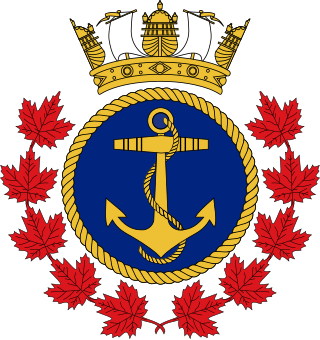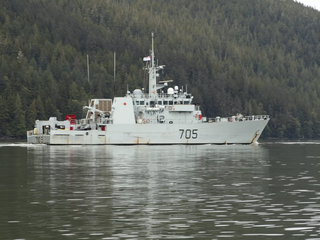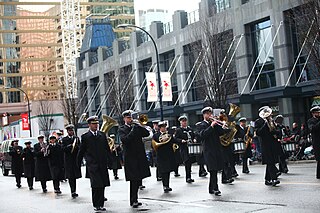Related Research Articles

The Royal Canadian Navy is the naval force of Canada. The RCN is one of three environmental commands within the Canadian Armed Forces. As of 2023, the RCN operates 12 frigates, four attack submarines, 12 coastal defence vessels, eight patrol-class training vessels, two offshore patrol vessels, and several auxiliary vessels. The RCN consists of 8,400 Regular Force and 4,100 Primary Reserve sailors, supported by 3,800 civilians. Vice-Admiral Angus Topshee is the commander of the Royal Canadian Navy and chief of the Naval Staff.
The history of the Royal Canadian Navy goes back to 1910, when the naval force was created as the Naval Service of Canada and renamed a year later by King George V. The Royal Canadian Navy (RCN) is one of the three environmental commands of the Canadian Forces. Over the course of its history, the RCN has played a role in the First World War, contributed significantly to the Battle of the Atlantic during the Second World War, and was a part of NATO's force buildup during the Cold War. In 1968, the RCN was amalgamated with the Canadian Army and the Royal Canadian Air Force to form what is today the unified Canadian Armed Forces. The naval force was known as Maritime Command until 2011, when the environmental command was renamed as the Royal Canadian Navy.

The Royal Canadian Sea Cadets is a Canadian national youth program sponsored by the Canadian Armed Forces and the civilian Navy League of Canada. Administered by the Canadian Forces, the program is funded through the Department of National Defence, with the civilian partner providing support in the local community. Cadets are not members of the Canadian Armed Forces.

HMCS Calgary is a Halifax-class frigate that has served in the Canadian Forces and Royal Canadian Navy since 1995. Calgary is the sixth vessel in her class and the second vessel to carry the designation HMCS Calgary. She was built as part of the Canadian Patrol Frigate Project. Calgary began the FELEX refit in June 2012. She is assigned to Maritime Forces Pacific (MARPAC) and is homeported at CFB Esquimalt. Calgary serves on MARPAC missions protecting Canada's sovereignty in the Pacific Ocean and enforcing Canadian laws in its territorial sea and exclusive economic zone.

HMCS Ottawa is a Royal Canadian Navy Halifax-class frigate. Ottawa is the twelfth and final ship of the Halifax class that were built as part of the Canadian Patrol Frigate Project. She is the fourth vessel to carry the name HMCS Ottawa. The first three were named for the Ottawa River. This ship is the first named for Canada's national capital, the City of Ottawa. She is assigned to Maritime Forces Pacific (MARPAC) and is homeported at HMC Dockyard, CFB Esquimalt. Ottawa serves on MARPAC missions protecting Canada's sovereignty in the Pacific Ocean and enforcing Canadian laws in its territorial sea and Exclusive Economic Zone. Ottawa has also been deployed on missions throughout the Pacific and to the Indian Ocean; specifically the Persian Gulf and Arabian Sea on anti-terrorism operations.

HMCS Ville de Québec is a Halifax-class frigate that has served in the Canadian Forces and Royal Canadian Navy since 1993. Ville de Québec is the third vessel in her class which is the name for the Canadian Patrol Frigate Project. The frigate is the second Royal Canadian Navy ship to be named Ville de Québec and is Canada's only fully bilingual warship. She is assigned to Maritime Forces Atlantic (MARLANT) and is homeported at CFB Halifax. The vessel serves on MARLANT missions protecting Canada's sovereignty in the Atlantic Ocean and enforcing Canadian laws in its territorial sea and exclusive economic zone.

HMCS Winnipeg is a Halifax-class frigate that has served in the Royal Canadian Navy since 1996. Winnipeg is the ninth ship in her class, whose design emerged from the Canadian Patrol Frigate Project. She is the second Canadian warship to carry the name HMCS Winnipeg. Winnipeg serves on Canadian Forces MARPAC missions protecting Canada's sovereignty in the Pacific Ocean and the Arctic Ocean and in enforcing Canadian laws on its territorial oceans and Exclusive Economic Zone. The vessel has been deployed on missions throughout the Pacific, and also to the Indian Ocean; specifically on anti-terrorism operations in the Persian Gulf and the Arabian Sea, and counter-piracy operations off the coast of Somalia. The ship is assigned to the Maritime Forces Pacific (MARPAC), and she has her home port at the Canadian Forces Maritime Base at Esquimalt.

HMCS Brandon is a Kingston-class coastal defence vessel that has served in the Canadian Forces since 1999. Brandon is the eleventh ship of her class. She is the second vessel to use the name HMCS Brandon. The Brandon is assigned to Maritime Forces Pacific (MARPAC) and is homeported at CFB Esquimalt.

HMCS Nanaimo is a Kingston-class coastal defence vessel that has served in the Canadian Forces and Royal Canadian Navy since 1997. Nanaimo is the third ship of her class. She is the second vessel to use the designation HMCS Nanaimo. She is assigned to Joint Task Force Pacific and is homeported at CFB Esquimalt.

HMCS Saskatoon is a Kingston-class coastal defence vessel delivered to the Canadian Forces in 1998. Saskatoon is the tenth ship of her class and is the second vessel to use the designation HMCS Saskatoon. Named after the Canadian city of Saskatoon, Saskatchewan, other references to the city are found on the ship with the ships captains desk named Cranberry Flats and a main corridor in the ship named after Idylwyld Drive. Saskatoon is assigned to Maritime Forces Pacific (MARPAC) of the Royal Canadian Navy and is homeported at Canadian Forces Base (CFB) Esquimalt.

HMCS Whitehorse is a Kingston-class coastal defence vessel that has served in the Canadian Forces since 1998. Whitehorse is the sixth ship of her class. The first vessel named for the city in the Yukon, the ship is assigned to Maritime Forces Pacific (MARPAC) and is homeported at CFB Esquimalt.

HMCS Carleton is a Canadian Forces Naval Reserve Division (NRD) located in Ottawa, Ontario, Canada. Dubbed a stone frigate, HMCS Carleton is a land-based naval training establishment crewed by part-time sailors and also serves as a local recruitment centre for the Canadian Forces Naval Reserve. It is one of 24 naval reserve divisions located in major cities across Canada.

HMCS York is a Royal Canadian Navy Reserve Division (NRD) located in Toronto, Ontario. Dubbed a stone frigate, HMCS York is a land-based naval establishment for part-time sailors as well as a local recruitment centre for the Canadian Naval Reserve.

In the Canadian Forces, Maritime Forces Pacific is responsible for the fleet training and operational readiness of the Royal Canadian Navy in the Pacific Ocean. It was once referred to as Canadian Pacific Station.

The Naval Reserve is the Primary Reserve component of the Royal Canadian Navy (RCN). The primary mission of the NAVRES is to force generate sailors and teams for Canadian Armed Forces (CAF) operations, including: domestic safety operations as well as security and defence missions, while at the same time supporting the Navy's efforts in connecting with Canadians through the maintenance of a broad national presence.
Operation Caribbe is the Canadian Armed Forces contribution to the elimination of illegal trafficking in the Caribbean Sea and the eastern Pacific Ocean by organized crime. The operation began in 2006 and its mandate has been altered twice since then.

The Naden Band of the Royal Canadian Navy is one of six regular force military bands of the Canadian Forces. The Royal Canadian Navy band is based at CFB Esquimalt in Esquimalt, British Columbia that serves as the official musical unit of the Canadian Forces Maritime Forces Pacific Command (MARPAC).
The Ceremony of the Flags is a Canadian military music event usually held by unit of the Royal Canadian Navy. Queen Elizabeth II, Queen of Canada, had started it in 1965. The display originated from the Sunset Ceremony that was held after the introduction of the Canadian Flag on Parliament Hill in 1965. The ceremony is also derived from the historical Beating Retreat that originated in the United Kingdom and a military tattoo. The first ceremony was held in 1967 in honor of Canada's centennial year celebrations. On Feb 15 1967, local cadet units and the HMCS Carleton Band performed during the first ceremony on Parliament Hill. It was the first ever flag day. For the most part, the Royal Canadian Sea Cadets perform the ceremony annually, with the most prominent one being held at CSTC HMCS Quadra. In years past, naval youth cadet organizations from Hong Kong, Australia, Sweden, South Korea, and the United Kingdom have been participants. The minimum requirement to perform the ceremony is 30 by 60 metres. This ceremony is performed once each year to honor the canadian flags.

Navy bands in Canada are part of the Royal Canadian Navy's command structure and overseen by the Music Branch of the Canadian Forces and the Directorate of History and Heritage of the Department of National Defence.
Michael Hopper is a Canadian Forces officer who served as commander of the Naval Reserve from July 29, 2018 until 2021. Hopper holds the rank of commodore in the Royal Canadian Navy and also works as a teacher with the Ottawa-Carleton District School Board (OCDSB).
References
- ↑ "Gerald Heatley Obituary - BC | The Times Colonist". legacy.com. Retrieved 15 March 2020.
- ↑ "[CAN-BC-OBITS] Victoria Times-Colonist; March 03, 2007". Rootsweb.Com. Retrieved 15 March 2020.
- ↑ "Francis Anderson Obituary - Toronto, Ontario | G.H. Hogle Funeral Home Limited". hoglefuneralhomes.com. Retrieved 15 March 2020.
- 1 2 3 4 5 6 "8 Apr 1967, Page 35 - The Ottawa Journal at Newspapers.com". newspapers.com. 8 April 1967. Retrieved 15 March 2020.
- ↑ Jerry Proc. "HMCS Gloucester". jproc.ca. Retrieved 15 March 2020.
- ↑ "Hmcs Carleton Navy Band, Bandmaster Petty Officer Hank Lec…". Flickr. Retrieved 15 March 2020.
- ↑ "Flickr". flickr.com. Retrieved 15 March 2020.
- ↑ "Main". ottawa-blues-jazz.ncf.ca. Retrieved 15 March 2020.
- ↑ "21 Jun 1969, Page 2 - The Ottawa Journal at Newspapers.com". newspapers.com. Retrieved 15 March 2020.
- ↑ "Don Durant shares some photos of Ottawa's very own HMCS Carleton band". m.facebook.com. Retrieved 15 March 2020.